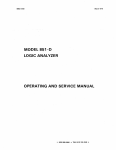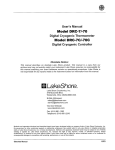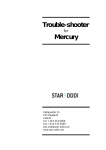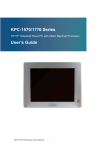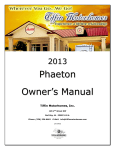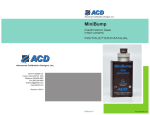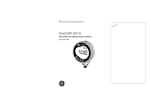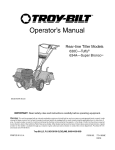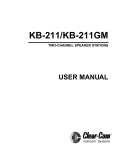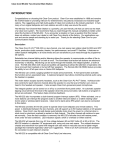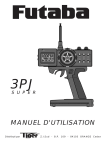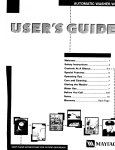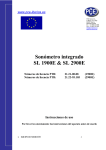Download GR 1987 Manual - IET Labs, Inc.
Transcript
♦ PRECISION INSTRUMENTS FOR TEST AND MEASUREMENT ♦ 1987 SERIES Minical Sound-Level Calibrator User and Service Manual Copyright © 2014 IET Labs, Inc. 1987 im/March, 2014 IET LABS, INC. Formerly manufactured by GenRad Long Island, New York - Email: [email protected] TEL: (516) 334-5959 • (800) 899-8438 • FAX: (516) 334-5988 www.ietlabs.com IET LABS, INC. Formerly manufactured by GenRad Long Island, New York - Email: [email protected] TEL: (516) 334-5959 • (800) 899-8438 • FAX: (516) 334-5988 www.ietlabs.com Specifications Appendix Output Sound-Pressure Levels: 114 dB or 94 dB re 20 JLPa t under reference conditions. USE OF THE NOMOGRAPH Output Frequency: 1000Hz ±3%. Reference Conditions: TEMPERATURE: 20°C (68°F). ATMOSPHERIC PRESSURE: 1013 mbart (760 mm of Hg) (30 in. of Hg). RELATIVE HUMIDITY: 65%. MICROPHONE EFFECTIVE VOLUME: 0.5 cm 3 (.03 in}) (nominal for GR 1961 Electret-Condenser Microphone*). Accuracy of Sound-Pressure Level: Under stated reference environment conditions, ±0.25 dB for cavity alone, or cavity when used with any adaptor (except 1-1/8-in, adaptor: ±0.5 d8). Temperature Coefficient of Sound-Pressure Level: Less than ±0.02 d8/°C. Power: Powered by 9-V alkaline battery; Mallory MN 1604 or Eveready 522 recommended. Battery provides at least 20 h continuous operation. Environment: TEMPERATURE: -10 to +50°C (+14 to +122° F), operating; -40 to+ 70°C (-40 to +140° F), storage with battery removed. HUMIDITY: 0 to 90% RH, operating. Mechanical: DIMENSIONS (wxhxd): Approximately 63x63x89 mm (2-1 /2x2-1 /2x3-1 /2 in.). WEIGHT: Approximately 270 gm (9.5 oz). ii CORRECTION OF BAROMETRIC PRESSURE TO STATIONAL TITUDE. To obtain a corrected barometric pressure for a station: a. Determine the station's altitude above sea level. b. Obtain a barometric pressure reading corrected to sea level from a barometer. (If the barometer reads only values in millimeters, find the corresponding value of millibars from the right-hand scales. c. Place a straight-€dge across the proper points on the center and left-hand scales of the nomograph, and read the actual pressure at the station, on the righthand scales. CONVERSION FROM MILLIMETERS OF MERCURY TO INCHES OF MERCURY. To convert from millimeters of mercury to inches of mercury proceed as follows: a. Find the barometric pressures value in millimeters of mercury on the right-hand scales. b. Obtain the corresponding value in millibars from the same scales. c. Move to the left-hand scales and find the millibar value obtained in step b. d. Read the corresponding value of barometric pressure in inches of mercury from the left-hand scales. 41 Battery Test: Internal circuitry checks condition of battery continuously. Calibrator will not operate at all if battery voltage falls below acceptable range. Microphone Coupling: Transducer cavity accommodates following 1-in. microphones: GR 1961 electret-condenser,* G R 1971 ceramic, Western Electric 640AA and Tokyo Riko MR103. Accessories Supplied: Coupler-adaptor to accommodate G R 1962 1/2-in electret-condenser microphone* and GR 1983 Sound-Level Meter micro· phone; carrying pouch; 3 spare desiccant kits; battery; instruction manual. Accessories Available: Adaptor set that includes coupler-adaptor for 3/S.in. GR 1954 Noise Dosimeter microphone, coupler-adaptors and "0" ring for 1·in., 1/2-in. and 1/4-in. 8 & K microphones, and coupler-adaptor for 1-1 /8·in. Shure Brothers microphone. tIn the international system of units (SI), the unit of pressure is the pascal (Pal; 1 Pa = 1 N/m 2 = 10 dynes/cm 2 = 1 mbar. Ref: "The International System of Units (SI)," U.S. Dept. of Commerce, National Bureau of Standards, NBS Special Publication 330. S.D. Cat. No. C 13. 10:330/2, U.S. GPO, Wash., D.C., 20402. *U.S. Patent 4,070.741. o·z iii Condensed Operating Instructions TO ACTIVATE THE INSTRUMENT a. Set power switch to desired calibration level (94 dB or 114 dB l. b. Listen for 1-kHz audible tone. If no tone is present, replace battery (see para 2.4). TO CALIBRATE A SOUND-MEASURING INSTRUMENT a. Observe 1987 desiccant through window. If pale blue, satisfactory; if pink, replace desiccants (see para 2.5!. b. If microphone adaptor is required, insert it in 1987 cavity to fit microphone under test (see para 2.6). c. Set instrument under test to 100 dB (if 1987 is set at 94 dB) or 120 dB (if 1987 is set at 114 dB). Instrument may be set to FAST or SLOW response and C or A weighting. d. Place 1987 on microphone of instrument under test, read level and adjust its sensitivity, A pressure-to-free-field correction (see para 2.1 0) must be added to this reading for some microphones (refer to following table); this correction (in dB) is to be added to the reading of the instrument under test before comparing it with the calibrated output of the 1987 (either 94 dB or 114 dB). Handbook of Noise Measurement This book, by Dr. A.P.G. Peterson and Ervin E. Gross, Jr., of the GenRad Engineering Staff covers thoroughly the subject of noise and vibration measurement. Copies are available from GenRad at $9.00 each, postpaid in the United States and Canada. GR P/N 5301-8111 iv PRESSURE-TO-FREE-FIELD CORRECTIONS* Microphone Manufacturer and Type GR Adaptor Used Correction (dBI FIat-Response-to-Random1ncidence Microphones: GR 1961-9610 or-9601 none ( 1-in. electretl G R 1962-9610 or -9601 1987-7061 ( 1/2-in. electret) GR 1971 (1-in. ceramic) none 1987-7061 GR 1983 Sound-Level Meter ( 1/2-in. ceramic) 1987-7076 GR 1954 Noise and Dosimeter (3/8-in. 1987-7095 ceramicl Flat-Response-toPerpendicu lar-1 ncidence Microphones: G R 1961-9611 or -9602 none ( 1-in. electret) G R 1962-9611 or -9602 1987-7061 ( 1/2-in. electret) 0-Ring B& K 4131 (1-in. ( 5855-6920) condenser It 1987-2050 B&K4133(1/2-in. condenser) 1987-2060 B&K4135(1/4-in. condenser) 0.0 0.0 0.0 0.1 0.0 ----- • DENOTES: END Or CAPAC !TORS., ARM or POTENTIOMETERS,ROTOR OF TBIMM[R CAPACITORS,CATHODE END OF DIOOES,PIN NO. I OF IC'S, PIN NO.I OF RELAYS,PiN NO.I OF CONNECTORS,COLLECTOR OF TRANSISTORS + Figure 5-1. Etched-board assembly (viewed from component side I. 38 0.3 0.1 0.2 0.0 0.0 *Measurement Conditions: Atmospheric Pressure, 760 mm (30 in.) of Hg (see para 2.9 for other pressures). t Additional correction required due to microphone effective volume (refer to para 2.11 ). v TABLE OF CONTENTS Parts Lists and Diagrams - Section 5 Specifications Condensed Operating Instructions 5.1 ELECTRICALPARTSLIST AND DIAGRAMS. Introduction- Section 1 1. 1 Purpose . . . . . . . . . . . . . . . . . . 1.2 Description . . . . . . . . . . . . . . . 1.3 Controls, Indicators and Connectors 1.4 Accessories . . . . . . . . . . . . . . . 1 1 2 2 Operation - Section 2 2.1 Unpacking and Inspection 2.2 Battery Installation 2.3 Battery Check . . . . . . 2.4 Battery Removal . . . . . 2.5 Desiccant Replacement . 2.6 Microphone Adaptors . . 2.7 Operational Check. . . . 2.8 Calibration of Instruments 2.9 Altitude and Pressure Corrections . 2.10 Pressure-to-Free-Field Corrections. . 2.11 Microphone- Volume Correction . 2.12 Use with G R 1954 Noise Dosimeter .. 7 7 8 10 10 12 14 15 18 20 22 24 Theory - Section 3 3.1 General . . . . . . . . . . . . 3.2 Circuit Description . . . . . Service and Maintenance - Section 4 4. 1 Customer Service . . . . . 4.2 Instrument Return . . . . 4.3 Performance Verification . 4.4 Disassembly . . . . . 4.5 Test and Calibration . . . . 4.6 Trouble Analysis . . . . . . Parts List and Diagrams - Section 5 5.1 Electrical Parts List and Diagrams • 5.2 Mechanical Parts • • . • . . • • 5.3 Federal Manufacturers' Codes . . . vi Figures 5-1 and 5-2 are, respectively, an etched-board diagram and a schematic diagram of the circuits and components in the 1987. An electrical parts I ist gives descriptions and part numbers for the electrical components shown in these figures. 5.2 MECHANICAL PARTS. Figure 5-3 shows locations of mechanical parts on the 1987 and the accompanying table gives their descriptions and associated G R and manufacturers' part numbers. 5.3 FEDERAL MANUFACTURERS' CODE. The federal manufacturers' code numbers for part-number identification codes are I isted at the end of this section. NOTE . 25 . 25 . 31 . 31 . . . . 32 34 34 36 Electrical-parts information in this section is presented in such a way that all component and circuit data are visible in a single opening of the manual. Thus, the part-location diagram appears on a left-hand page, while the parts list and schematic diagram are on a right-hand apron and tip-out page . • 37 • 37 . 37 37 equivalent, that possess a known level of response traceable to the National Bureau of Standards. Potentiometers R 12 and R 13 are gain controls that are used to adjust the 114-dB and 94-dB levels, respectively, re 20 J.LPa. These two controls should not be tampered with unless a full calibration facility exists. The two adjustments are accessible from the top of the instrument when the powerswitch plate is removed; this is accomplished by first taking off the nut and lockwasher that secure the small toggle switch to the housing, and then lift. ing the switch plate off of the unit. The two adjustments referred to are each covered by an adhesive disk; when the disks are removed, the adjustments are accessible through the two small holes in the top housing, one on each side of the switch (see Figure 2·1). 4.6 TROUBLE ANALYSIS. When a malfunction is suspected in the 1987, it is first recommended that the performanceverification procedure of para 4.3 be conducted. This will usually establish if there is a problem with the unit. The 1987 should only be worked on by personnel skilled in the repair of delicate electronic equipment. A detailed schematic diagram and parts list are included in Section 5, and circuit descriptions in Section 3. The schematic includes waveforms and voltages to aid in troubleshooting. If the 1987 undergoes any repair that will alter its acoustical output, it is essential that recalibration be performed. This is described in para 4.5. It is important to note that a special calibration facility is required for this procedure. 36 Introduction- Section 1 NOTE Batteries shipped uninstalled. See para 2.2. 1.1 PURPOSE. The GR 1987 Minical Sound-Level Calibrator is a compact, self-contained device for checking the calibration of sound-measuring instruments. It is intended for field use on a wide variety of soundlevel meters, analyzers or sound-measuring systems that contain a microphone adaptable to its cavity. 1.2 DESCRIPTION. The GR 1987 Minical produces a 1000-Hz tone at sound-pressure levels (SPL) of either 94 dB or 114 dB. An SPL of 94 dB represents the reference SPL * recommended in the forthcoming I EC Consolidated Revision Standard;t an SPL of 114 dB is sufficiently above most ambient noise or vibration sources to provide accurate calibration where these sources are present. The 1987 features a ruggedized package that is resistant to moisture, dust and mechanical shock. The cavity of the 1987 will accommodate all G R 1-in. electret-condenser microphones, GR 1-in. *The reference sound-pressure level is that level recommended by the manufacturer for calibrat· ing the absolute sensitivity of a sound-level meter. tRef: "Draft: Instruments for the Measurement of Sound Level (Sound Level Meters)," to supersede IEC Publications 123, 179 and 179A upon final approval; International Electrotechnical Commission, 1 Rue de Varemb9, Geneva, Switzerland. Table 1-1 CONTROLS, INDICATORS AND CONNECTORS Fig.1·1 Ref. 1 Name Description Function Battery Compartment Recess in 1987 Contains 9-V alkaline battery for providing instrument power. housing; access obtained by removing cover secured by thumbscrew. 94 dB/OFF/ 114dB 3-position toggle switch. OFF -disconnects instrument from its internal battery source. 94 dB - selects calibrated output level of 94 dB re 20 ,.Pa. 114 dB - selects calibrated output level of 114 dB re 20 ,.Pa. 3 Desiccant Window Small, circular window on 1987 housing. Provides observation of desiccant to determine its condition; pale blue means satisfactory, pink means replacement necessary. 4 Transducer Assembly Contains electromagnetic transducer and 1-in. cavity for microphone insertion, Provides acoustical output signal to calibrate a soundmeasuring instrument; cavity allows tight acoustical coupling to a microphone. CONNECT 9-V BATTERY HERE FOR EXTERNAL POWER Figure 4-1. Circuit board (P/N 1987-4700). 2 35 g. Select the 94-dB level on the 1987. Again observe the reading on the 1982; it should be 94 dB, ± 1.25 dB. The wider tolerance allows for linearity errors within the sound-level meter itself. Any 1987 that fails to perform properly should be returned to an authorized GenRad service facility, as described in para 4.1 and 4.2. 4.4 DISASSEMBLY. The circuitry of the 1987 is contained on one small board. To gain access to this board, which is normally required for troubleshooting procedures only, proceed as follows: a. Disassemble the housing of the 1987 as described in para 2.5 and Figure 2-1. b. In order to remove the board, first remove the nut and lock washer that secure the power switch (toggle switch) to the housing of the 1987. c. Remove the one screw on the component side of the board; this will allow the board to drop out of the housing. d. The board can be powered externally by connecting a 9-Vdc supply or battery to WT3(+) and WT4(-) (see Figure 4-1 ). 4.5 TEST AND CALIBRATION. Special facilities are required to calibrate the output \eve\ of the 1987 Minica\ so that it, in turn, can be used to calibrate sound-measuring instruments in accordance with ANSI and I EC standards. Such facilities are available at the GenRad factory and service centers, and are used in the initial factory calibration or repair of the 1987 units. These facilities must include a standard microphone, such as the Western E \ectric Co. Type 640AA or its Figure 1-1. Controls, indicators and connectors. 34 3 ceramic microphones, the Western Electric 640AA (or equivalent microphone) and the Tokyo R iko MR 103 microphone. The 1987 is also supplied with an adaptor that accommodates GR 1/2-in. electret-condenser microphones. An optional adaptor set (P/N 1987-9600) is available to accommodate the 3/8-in. microphone used on the G R 1954 Noise Dosimeter, the B & K 1-in., 1/2-in. and 1/4-in. microphones and the Shure Brothers' 1-1/8-in. microphone. 1.3 CONTROLS, INDICATORS AND CONNECTORS. Figure 1-1 illustrates GR 1987 controls, indicators and connectors; Table 1-1 describes these items. 1.4 ACCESSORIES. Model G R 1987-3000 signifies the Minical Sound-Level Calibrator only, with no accessories. Model GR 1987-9700 signifies the instrument included with the accessories illustrated in Figure 1-2 and described in Table 1-2. Figure 1-3 illustrates the six microphone adaptors included in the optional G R 1987-9600 Microphone Adaptor Set, an accessory available by order from GenRad; Table 1-3 describes these adaptors. 4 accuracy traceability to the National Bureau of Standards. A precision sound-level meter, such as the G R 1982 or its equivalent, should be used for this performance test. a. The calibration of the 1982 should first be checked, and adjusted if necessary, using another calibrator with a known accuracy correct to within ±0.5dB. AGR 1986,GR 1562orGR 1567can be used for this purpose. To calibrate the 1982, set its controls as follows: Power Switch . . . . . . . . . . . . . ON DIGITAL DISPLAY: . . . . .. cant OCTAVE FILTER FREO: 1 k (Hz) dB RANGE: . . . . . . . . . 70-120 DETECTOR: . . . . . . . . . . . . FAST b. Set the controls on the calibrator being used to a level of 114 dB and a frequency of 1 kHz. Install the appropriate microphone adaptor in the calibrator being used to accommodate the 1/2-in. microphone on the 1982, and then carefully place the calibrator over the microphone of the 1982. c. Observe the 1982 digital display, and adjust its CAL control for a reading of exactly 114.0 dB. The 1982 is now accurately calibrated to within ±0.5 dB. d. Insert the 1/2-in. microphone adaptor (P/N 1987-7061) in the 1987 transducer cavity. e. On the 1987 under test, set the 114dB/OFF/ 94dB power switch to 114 dB, and then carefully mount the calibrator over the microphone of the 1982. f. Observe the reading on the 1982; it should be 114 dB, ±0.5 dB. 33 4.2.2 Packaging To safeguard your instrument during storage and shipment, please use packaging that is adequate to protect it from damage, i.e., equivalent to the original packaging. Any GenRad field office can advise or provide packing material for this purpose. Contract packaging companies in many cities can provide dependable custom packaging on short notice. Here are two recommended packaging methods. Rubberized Hair. Cover the painted surfaces of the instrument with protective wrapping paper. Pack the instrument securely in a strong protective corrugated container, which has a 25-kg/cm (350-lb/sq in.) bursting test, with 5-cm (2-in.) rubberized hair pads placed along all surfaces of the instrument. Insert fillers between the pads and the container to ensure a snug fit. Mark the box "Delicate Instrument" and seal it with strong tape. Excelsior. Cover the painted surfaces of the instrument with protective wrapping paper. Pack the instrument in a strong corrugated container, which has a 25-kg/cm (350-lb/sq in.) bursting test, with a layer of excelsior about 15-cm (6-in.) thick packed firmly against all surfaces of the instrument. Mark and seal the box as described above. 4.3 PERFORMANCE VERIFICATION. The following procedure is intended as a quick check of the 1987, and is distinct from the test and calibration procedures in para 4.5 that require 32 \ 3 DESICCANT KITS Figure 1·2. Accessories supplied with GR 19879700 (instruction manual not shown). Table 1-2 ACCESSORIES SUPPLIED WITH GR 1987-9700 Description GR P/N Minical Sound-Level Calibrator, instrument only 1987-3000 Adaptor for 1/2-in. microphone 1987-7061 Battery, 9-V alkaline 8410-3400 3 Desiccant Kits ( 2 desiccant cartridges per kit) 5873-3001 Pouch 1987-0420 Instruction Manual 1987-0100 5 Service and Maintenance - Section 4 CAUTION The servicing instructions in this section should be performed by qualified personnel only. Figure 1-3. GR 1987-9600 Microphone Adaptor Set (available accessory). Table 1·3 GR 1987-9600 MICROPHONE ADAPTOR SET Description GR P/N 4.1 CUSTOMER SERVICE. Our warranty (at the front of this manual) attests the quality of materials and workmanship in our products. If malfunction does occur, our service engineers will assist in any way possible. If the difficulty cannot be eliminated by use of the following service instructions, please write or phone the nearest GenRad service facility (see back page), giving full information of the trouble and of steps taken to remedy it. Describe the instrument by name, catalog number, serial number, and ID (lot) number if any. (Refer to front and rear panels.) 4.2 INSTRUMENT RETURN. Box (for adaptors below): 1987-1800 4.2.1 Returned Material Number. 1954 Microphone Adaptor 1987-7076 1954 Microphone-A~aptor Cap 1987-7095 "0" Ring (forB & K Type 4131/32 1-in. microphone) 5855-6920 Adaptor (forB & K Type 4133/34 1/2-in. microphone) 1987-2050 Adaptor (for B & K Type 4135/36 1/4-in. microphone) 1987-2060 Before returning an instrument to GenRad for service, please ask our nearest office for a" Returned Material" number. Use of this number in correspondence and on a tag tied to the instrument will ensure proper handling and identification. After the initial warranty period, please avoid unnecessary delay by indicating how payment will be made; i.e., send a purchase-order number. Adaptor (for Shure Bros. Model 98108 1-1/8-in. microphone) 1987-7066 6 31 Operation - Section 2 2.1 UNPACKING AND INSPECTION. If the shipping carton is damaged, ask that the carrier's agent be present when the instrument is unpacked. Inspect the instrument for damage (scratches, dents, broken parts, etc). If the instrument is damaged or fails to meet specifications, notify the carrier and the nearest GenRad field office. (See list at back of this manual.) Retain the shipping carton and the padding material for carrier's inspection. The battery must be installed in the 1987 to make it operable. Para 2.2 gives the procedure for battery installation. A small circular window in the 1987 housing provides observation of a desiccant cartridge that is used for moisture control. If pale blue, the desiccant is satisfactory; if pink, replacement is necessary. Refer to para 2.5 for replacement procedures. 2.2 BATTERY INSTALLATION. The 1987 is shipped with the battery removed. A 9-V alkaline battery is included with the accessories, and this is the only type of battery recommended for use that will provide an optimum operating life.* A new alkaline battery will provide approximately 20 h of continuous operation. *GenRad recommends Mallory MN 1604 or Eveready 522. 7 To install the battery, proceed as follows (refer to Figure 2-1): a. Loosen the thumbscrew (ccw direction) that secures the battery-compartment cover. This screw is captivated so that it will remain with the cover once loosened. b. Grasp the thumbscrew and lift the cover away from the 1987 housing. c. Before inserting the battery, observe its polarity with respect to the battery out I ine shown inside the compartment. d. Push the bottom of the battery against the foam to compress it. Simultaneously push the other end of the battery (terminal end) into the compartment such that it is firmly seated and makes contact with the spring-metal contacts. e. Replace the battery-compartment cover by sliding its rear edge under the rear-edge of the battery compartment until the thumbscrew lines up with its threaded hole in the 1987 housing. Then seat the cover flush on the lip that is built into the compartment, and tighten the thumbscrew (cw direction) to secure the cover to the unit. 2.3 BATTERY CHECK. If the battery voltage is not adequate, there will either be no acoustical output, or the output will cut out after being on for a short time. To check for sufficient battery voltage, proceed as follows: net attenuation in this positive feedback load is slightly less than the gain of the bridge filter to ensure that the oscillator starts. 3.2.5 Transducer Driver. This circuit is comprised of two level adjustments (R12 and R13) and a current-source amplifier (U1 D). The output of the 1-kHz oscillator is selected by one side of the 114dB/OFF/94dB switch (S1) and is fed through one of two paths to the current-summing node of operational-amplifier U 1D. Each path has a gain control for adjusting the calibration of the 1987; R 12 provides adjustment of the 114-dB level, and R 13 is the 94-dB level adjustment (refer to para 4.5 and Figure 4.1 ). The current-source amplifier, U1D, is used to drive the output transducer, LS-1, which provides the acoustical output to a sound-measuring instrument under test. Since the transducer is an electromagnetic device with an acoustical output proportional to the current in its magnetic field, it is placed in the amplifier feedback loop, which provides a constant-current source. If the transducer had been driven from a voltage source, the current in the field would have depended on the coilwinding resistance, which is temperature dependent. Capacitor C6 is used to roll off high frequencies, thus eliminating some upper harmonics. Resistor R 10 allows testing of the transducer current at TP2. a. Set the power switch to the 94-dB or 114-dB position. 8 29 to 0 V (1.5- 1.5 V), causing its output voltage to also drop. When the output of U 1C shifts to a low voltage, CR2 conducts; this places an added load on the oscillator-feedback circuit, causing oscillations to cease. 3.2.4 Bridge Oscillator. The bridge-oscillator circuit is comprised of a 1-kHz bandpass filter (U1A), a soft limiter (RB, CR3 and CR4) and a temperature-compensating attenuator ( R4 and R3/R 14). The bandpass filter, U1A, is an active-filter operational amplifier with a bridge-null network in the feedback loop. The overall center frequency, stage gain and Q are determined by the ratios of the five bridge components. The phase shift across the network is zero at center frequency, The stage gain is approximately 34 dB. In order to make the circuit oscillate, the output of U 1A is returned to its noninverting terminal through an appropriate attenuator. The soft limiter, consisting of RB, CR3 and CR4, limits the output of the bandpass filter to ensure long-term stability, If the U 1A output were fed back directly to its input without passing through this limiter, oscillation would still occur, but would build up in amplitude until limited by the output swing of U 1A. The soft limiter maintains the U 1A output at a constant level of approximately 1.2 V pk-pk. The distortion produced by the limiting is later filtered by the 1-kHz bandpass filter. The "soft" limited signal is attenuated by R4 and R3/14. The latter two resistors, R3 and R 14, are used to temperature-compensate the natural temperature-shift effects of CR3 and CR4. The 28 LABEL AND NUT REMOVED FROM POWER -=~-·" ASSEMSL Y SCREWS REMOVED FROM BATTERY COMPARTMENT Figure 2-1. GR 1987 disassembled. g b. If the battery is up to operating voltage and the 1987 is functional, a tone of 1 kHz will be audible. c. If this audible tone is not present, the battery should be replaced. Refer to para 2.4 and 2.2 for battery-removal and installation procedures. 2.4 BATTERY REMOVAL. CAUTION The battery should be removed whenever the 1987 will not be used for 6 months or more to prevent corrosion on the terminals. To remove batteries for replacement or storage, proceed as follows (refer to Figure 2-1): a. Loosen the captive thumbscrew (ccw direction) that secures the battery-compartment cover. b. Grasp the thumbscrew and lift the cover away from the 1987 housing. c. Place one finger, or tool like a small screwdriver, on the terminal end of the battery, and push it to compress the foam on the other end; with the same finger or tool, pull up slightly until the battery pops out. 2.5 DESICCANT REPLACEMENT. The 1987 contains two desiccant cartridges inside its transducer section (refer to Figure 2-1) in order to keep the interior humidity low relative to any high external humidity. The desiccants are used to minimize the effects of humidity upon the transducer, which produces a more stable output 10 3.2.2 Battery and Power-Supply Splitter. The power source for the 1987 is a single 9-V alkaline battery. Approximately 20 h of continuous operation are available from a new battery. Since the operational-amplifier circuits require both plus and minus supplies, the battery output is split into equal positive and negative voltages by resistors R1 and R2 and "splitter" U1B (the output of U 1B is the reference for ground). Capacitors C 1 and C2 provide filtering as the battery's impedance increases with discharge. 3.2.3 Battery-Low Test Circuit. This circuit is comprised of U 1C, 01, CR 1 and CR2. The purpose of the circuit is to detect the power-supply output and disable the bridgeoscillator circuit for a low or dead battery. This results in an automatic-shutdown capability to prevent the 1987 from generating a low-level, outof-calibration or drifting signal because of insufficient battery power. This is especially important if the 1987 is used as a system calibrator where it is left unattended while the system levels are monitored and adjusted. The battery-low detector works as follows. The battery voltage is impressed across the currentsource, 01, and the 5-V Zener, CR1 (which has a low temperature coefficient). When the battery voltage is 9.0 V, the voltage at the cathode of CR1 is 0.5 V (-4.5 V plus 5.0 V); then the voltage at the input to the comparator (U 1C) is 1.5 V below the cathode of CR1, or -1.0 V, causing CR1 to conduct. If the battery voltage has a 1.5-V drop from 9.0 V to 7.5 V, the anode voltage of CR1 becomes -3.5 V, and its cathode voltage becomes + 1. 5 V; now the comparator input voltage drops 27 SIA +V(3.ST04,'5'V) GND -v(-::~.s To-4. 5V) r-----------------, : I 'TRANSDUCER 'DRIVER CURRENT FEE08...CI< I I I ll'lclll( CURRENT '.:>OUR<E 1'11'\PL.IF'IER 94dBI 1---;-"'-J UID ~~d~/P<!d'B when dry. These two cylindrical cartridges are about 4 em (1-5/8 in.) in length and 8 mm (3/8 in.) in diameter. One of the desiccants is visible through the small circular window on the 1987 housing; this desiccant will change color from pale blue to pink when it has absorbed moisture, and such an indication means that the two desiccants should be replaced by dry ones. Three spare desiccant kits (each kit contains two cartridges) are included with the accessories supplied; they are contained in an air-tight package. The desiccants are made of a super-activated silica-gel (S02) fill. They have a high moistureabsorption capability and are fast drying. They can be rejuvenated by baking at 80°C ( 170° F) until they turn blue. To replace the desiccants, proceed as follows (refer to Figure 2-1): a. Remove the battery-compartment cover and battery (detailed in para 2.4). b. Remove the two Phillips-head screws that are visible inside the compartment once the battery has been removed. c. Grasp the bottom section of the 1987 with one hand, the top section with the other, and pull off the top section; the separation will occur at the rubber gasket between the two sections. d. Each desiccant cartridge is held in place on the transducer-housing assembly by two clips, one on each end (see Figure 2-1 ). To replace a desiccant, slide it out from under the clips, and then slide a replacement cartridge back under the clips. I @ 1 I<H~ L--- --------------.J Figure 3-1. Block Diagram. 26 11 e. Before reassembling the transducer assembly, check to see if the two wires that connect to the transducer became unplugged. If so, they should be connected to the terminals labelled WT 1 and WT2 on the circuit board. These two connections are nonpolarized and interchangeable (refer to Figure 4-1 ). f. Replace the top section of the 1987 on the lower section. Note that the two spacers (see Figure 2-1) that accept the Phillips-head screws are offset from the center of the housing such that there is only one orientation that mates the top section with the bottom section. Both the top and bottom sections should be firmly seated into the rubber gasket before the two Phillips-head screws are tightened; after securing these two screws, make sure the gasket has seated properly. (It can be properly seated by running a fingernail around its edge.) g. Replace the battery and battery-compartment cover. 2.6 MICROPHONE ADAPTORS. 2.6.1 General. The cavity of the 1987 will accommodate the following 1-in. microphones: the GR 1961 ElectretCondenser, the GR 1971 Ceramic, the Western Electric 640AA, and the Tokyo Riko MR103. Adaptors must be used for other-sized microphones. The 1/2-in. microphone adaptor, P/N 19877061, is an accessory included with the 1987. It must be inserted into the cavity of the transducer assembly when calibration is being performed on an instrument with a GR 1/2-in. electret-condenser 12 Theory - Section 3 3.1 GENERAL. The 1987 Minical calibrator is a single-frequency, secondary-standard* sound source that can calibrate sound-level meters in the field. The 1987 provides the user a quick means of checking soundlevel meters at 1 kHz and at two reference soundpressure levels: 114 dB and 94 dB. The 1987 calibrates 1-in. (nominal) microphones directly without an adaptor, and a variety of other standard microphones with adaptors supplied or available as accessories. 3.2 CIRCUIT DESCRIPTION. 3.2.1 General. Figure 3-1 is a block diagram of the 1987; etched-board and schematic diagrams are given in Section 5. All of the electrical components, except the transducer and battery, are contained on the calibrator's only etched board (P/N 19874700), shown in Figure 4-1. The block diagram shows the following main elements of the 1987 circuitry: • • • • battery and power-supply splitter battery-low test circuit bridge asci llator transducer driver The paragraphs below discuss these circuits. *As differentiated from a "primary-standard" calibrator that contains a transducer with a known level of response traceable to the National Bureau of Standards (see para 4.5). 25 2.12 USE WITH GR 1954 NOISE DOSIMETER. The calibration of the monitor on the G R 1954 Noise Dosimeter can be checked using the 1987 in place of the 1954 Indicator's calibrator. The G R 1987-7076 Adaptor and G R 1987-7095 Adaptor Cap are required; these are included in the GR 1987-9600 Microphone Adaptor Set. The calibration procedure follows: a. Insert the 1954 Monitor into the 1954 Indicator as normally done for a routine calibration check (refer to the 19541nstruction Manual). b. Set the dB RANGE switch on the 1954 Monitor to 80-130 dB, and the ON/HOLD switch to ON. c. Insert the 1954 Microphone into the 1987 cavity, using the 1987-7076 Adaptor and 19877095 Adaptor Cap (refer to para 2.6.3 for instructions on installing adaptors). d. Set the power switch on the 1987 to 114 dB. e. Reset the monitor by depressing DISPLAY and RESET simultaneously on the indicator. f. Depress the CALIBRATE button on the 1954, and hold it for 10 s until the display reaches a steady value. Adjust the CAL control on the monitor for a reading on the indicator of 0.087. This number applies to the 1954-9710 Monitor, which has a 5-dB exchange rate. The calibration number of the 1954-9730 Monitor is 0. 78. A cross-check of the above calibration can be made by comparing the results using the 1987 calibrator with the results using the 1954 Indicator's calibrator. Some discrepancy is likely, and the tolerance of the 1987 output level and the 1954 Indicator output level must be taken into account when making this comparison. 24 microphone. Adaptors for microphones other than GR 1/2-in. and 1-in. microphones are available in an accessory kit, P/N 1987-9600, which is described below. The GR 1987-7061 Microphone Adaptor is inserted by gently pushing it into the cavity until the three detents inside the cavity fall into the groove around the outside of the adaptor. Make sure it is firmly seated. To remove the adaptor, grasp its outer flange that extends out of the cavity, and pull it out. 2.6.2 GR 1987-9600 Microphone Adaptor Set. This optional set is an accessory available by order from GenRad. It includes six microphone adaptors that are necessary to accommodate various microphones on instruments under test. The base of each adaptor is marked with its appropriate part number; Figure 1-3 and Table 1-3 illustrate and describe the adaptors in this set. The six adaptors in this set are inserted in the transducer cavity as described below: • GR 1987-2050 Microphone Adaptor for B & K Type 4133/341/2-in. microphone: insert in same manner as 1987-7061 adaptor. This adaptor appears similar to the GR 1987-7061 1/2-in. adaptor, except for an 0-ring and minor dimensional differences inside the B & K adaptor. NOTE The GR 1987-2050 and GR 1987-7061 adaptors are not interchangeable. • G R 1987-2060 Microphone Adaptor for B & K Type 4135/36 1/4-in. microphone: insert in the same manner as 1987-7061 adaptor. 13 • GR 1987-7066 Microphone Adaptor for Shure Bros. Model 98108 1-1/8-in. microphone: insert in the same manner as 1987-7061 adaptor. • GR 5855-6920 0-ring for B & K Type 4131/32 1-in. microphone: place it in the cavity and, with the index finger, work it into the groove all the way around the inside of the cavity. G R 1987-7076 Microphone Adaptor and G R 1987-7095 Adaptor Cap for 3/8-in. microphone (used on G R 1954 Noise Dosimeter) - proceed as follows: • a. Set the microphone cap (P/N 19877095) flat side down on a bench or table. b. Insert the 3/8-in. microphone into the cap with the front side up. Make sure the microphone cable slides into the groove on the side of the cap as the microphone is inserted. c. Place the GR 1987-7076 Microphone Adaptor over the cap such that the groove in the side of the adaptor fits over the cable from the microphone. d. Insert the microphone-cap-adaptor assembly into the 1987 transducer cavity in the same manner as the adaptor described in para 2.6.1 was installed. CAUTION The transducer should not be in contact with a surface subject to vibration when calibration is performed. This can introduce an ambient level significant enough to give a false calibration indication. 14 to the SPL when it is calibrated by the 1987. Also, no microphone-volume correction is necessary for other G R 1-in. electret-condenser microphones, G R 1-in. ceramic microphones, the Western Electric 640AA microphone or the Tokyo Riko MR 103 microphone. The microphone effective volume of the 1-in. B & K 4131/4132 Microphone has a significant enough discrepancy from the idealized volume (0.5 em') that a microphone-volume correction is necessary. This correction is given in Table 2-2; it should be added to the SPL indication on an instrument that utilizes the 4131/32 microphone when that instrument is calibrated by the 1987. When the 1/2-in. microphone adaptor (P/N 1987-7061, supplied with the 1987) is used to calibrate a G R 1/2-in. electret-condenser microphone, no microphone-volume correction is necessary, Likewise, when any of the adaptors (except the 5855-6920 0-ring adaptor for the B & K 4131/32 Microphone cited above) included in the optional G R 1987-9600 Microphone Adaptor Set are used with their intended microphones (refer to Table 1-3), no microphone-volume correction is necessary. Table 2-2 MICROPHONE-VOLUME CORRECTION* Microphone Type Adaptor Used Correction B & K 4131/32 ( 1-in. Condenser) 0-Ring (5855-6920) 0.4 (dB) *To be added to the sound-pressure-level indication of the meter under test. 23 Sound-level meters that comply with the ANSI S1.4-1971 * standard use a microphone idealized for a random-incidence response, whereas meters that comply with the I ECt standards use a microphone idealized for a perpendicular-incidence response. 2.11 MICROPHONE-VOLUME CORRECTION. The sound-pressure level (SPL) developed in the 1987 transducer cavity is dependent upon the volume of air between the diaphragm of the microphone being calibrated and the diaphragm of the 1987 transducer. A portion of that volume between the two diaphragms, namely, the particular volume comprised by the space between the front face of the microphone and its diaphragm, is referred to as the "microphone effective volume." The 1987 transducer cavity is designed to produce a 94-dB or 114-dB SPL upon the diaphragm of a 1-in. microphone that has an "effective volume" of 0.5 cm 3 (.03 in. 3 ). The 1-in. GR 1961 Electret-Condenser Microphone has this idealized effective volume, and thus requires no correction • Ref: "American National Standard Specification for Sound Level Meters," ANSI S1.4-1971, published 1971, American National Standard Institute, Inc., 1430 Broadway, New York, N.Y. 10018. t Ref: "Recommendations for Sound Level Meters," Publication 123, published 1961; "Precision Sound Level Meters," Publication 179, published 1973; "Precision Sound Level Meters, Additional Characteristics for the Measurement of Impulsive Sounds," Publication 179A, published 1973; International Electrotechnical Commission, 1 Rue de Varembe, Geneva, Switzerland. 22 2.7 OPERATIONAL CHECK. To quickly check the operation of the 1987 before using it, proceed as follows: a. Turn the power switch from OFF to the 94-dB position, and listen for a 1000-Hz audible tone; this indicates that the instrument is working. If no tone is evident, the battery may need replacement; refer to para 2.4 for battery replacement. b. Change the switch from 94 dB to 114 dB; the 20-dB increase in level of the 1000-Hz tone should be easy to detect audibly. 2.8 CALIBRATION OF SOUND-MEASURING INSTRUMENTS. 2.8.1 General. Before a sound-level meter or analyzer is used to make a measurement or analysis, its sensitivity should be checked. The 1987 Minical Sound-Level Calibrator provides a calibrated output to ensure that the sensitivity of a particular piece of sound-measuring equipment (including microphone) is properly adjusted. The 1987 generates two levels of output, 94 dB and 114 dB re 20 1-'Pa, at a frequency of 1000Hz. 2.8.2 Calibration. The sensitivity of a sound-level meter or analyzer is checked by placing the transducer cavity of the 1987 over the microphone of the instrument under test. The instrument is then adjusted to indicate the known level, either 94 dB or 114 dB. Figure 2-2 shows the setup for this sensitivity check with a typical sound-level meter. The following procedure is suggested as a means to check and adjust the sensitivity of an instrument. 15 Table 2-1 PRESSURE-TO-FREE-FIELD CORRECTIONS* Microphone Manufacturer and Type Flat-Response-to-RandomIncidence Microphones: GR 1961-9610 or -9601 (1-in. Electret) GR 1962-9610 or -9601 (1/2-in. Electret) GR 1971 (1-in. Ceramic) GR 1983 Sound-Level Meter 11/2-in. Ceramic) G A 1954 Noise Dosimeter (3/8-in. Ceramic) - - - - - FIat-Response-to-Per pend icu larIncidence Microphones: GR 1961-9611 or-9602 (1-in. Electret) GR 1962-9611 or-9602 (1/2-in. Electret) B & K 4131 (1-in. Condenser)t B & K 4133 (1/2-in. Condenser) B & K 4135 (1/4-in. Condenser) GR Adaptor Correction.6. Used (dB) none 0.0 1987-7061 0.0 none 1987-7061 0.0 0.1 1987-7076 and 1987-7095 0.0 none 0.3 1987-7061 0.1 0-Ring (5855-6920) 0.2 1987-2050 0.0 1987-2060 0.0 - - - - • Measurement Conditions: Atmospheric Press ure, 7~0 mm (30 in.) of Hg. 0 Temperature, +20 C (68 F). .6.To be added to sound-pressure level indication of meter under test before It is compared with level Indicated on 1987 label by power switch, t Additional correction required due to microphone effective volume (refer to para 2.11). Figure 2-2. 16 Typical calibration setup. 21 2.10 PRESSURE·TO·FREE-FIELD CORRECTIONS. When the 1987 transducer is tightly coupled to a microphone within its cavity, it creates a microphone frequency-response condition referred to as "pressure response." Pressure response is characterized by a sound field that produces a uniform sound pressure over the diaphragm surface of a microphone. This condition is realized by the 1987 when the microphone being calibrated is tightly coupled within its specially shaped cavity of small volume. Most microphones used in sound-measuring instrumentation are designed for one of two kinds of response: either a flat-frequency response to sounds of random incidence in a free field, or a flatfrequency response to sounds of perpendicular (with respect to the plane of the microphone's diaphragm) incidence in a free field. Since such free-field incidence is not simulated by the 1987, with its tight pressure coupling within a cavity of small dimensions, correction factors are sometimes necessary for either of these two types of microphone when calibrated with the 1987. The amount of correction factor that is required depends on the type of microphone being calibrated. Table 2-1 gives the pressure-to-free-field corrections that are necessary for various microphones. These corrections factors are computed from the difference between the perpendicular or random response that a microphone is designed for, and the actual pressure response within the cavity of the 1987. Thus, a correction will always result in adjusting the sensitivity of the instrument under test for a reading lower than the level indicated on the 1987 label by the power switch. 20 CAUTION Ambient sources of noise or vibration can cause a false calibration indication; this can be especially significant at the lower 94-dB level. a. Insert the proper adaptor, if one is required, into the cavity of the 1987 to fit the particular microphone under calibration (refer to Table 1-3). b. Set the 1987 power switch to the 94-dB or 114-dB position, depending on the desired level of calibration. (Select the level closest to the upper limit of the level range intended for measurement.) c. An audible tone of 1 kHz should be present from the calibrator; if not, the battery may need replacement (refer to para 2.4). d. Place the 1987 Minical over the microphone of the sound-measuring instrument being calibrated. e. On the instrument under test, set the LEVEL RANGE control to the range having 100 dB as its upper limit if 94 dB was selected on the 1987; or, if 114 dB was selected on the 1987, choose a range with an upper limit of 120 dB. The instrument may be set to FAST or SLOW response and C or A weighting. f. Read the level on the instrument under test, and adjust the sensitivity control for the correct indication of the 1987 level selected in step e. It is important to note that a pressure-to-free-field correction must be made to this indication for some microphones (this subject is discussed in para 2.1 0). Normal variation of temperature and atmospheric pressure will have negligible effect on the sound-pressure level developed from the 1987. Altitude-pressure corrections are given in para 2.9; these must be taken into account for a calibration made well above sea level. 17 g. An example of a pressure-to-free-field correction follows: Condition of measurementMicrophone Type G R 1962-9611 ( 1/2-in. electret, flat perpendicular). Correction from Table 2-1 0.1 dB. For this example, adjust the sensitivity of the instrument under test for an indication 0.1 dB below the level selected on the 1987. For example, if the 1987 is set to 94 dB, adjust the instrument's ~ensitivity for a reading of 93.9 dB. 2.9 ALTITUDE AND PRESSURE CORRECTIONS. The acoustical output of the 1987 is equal to 94 dB or 114 dB, depending on the selection, at a normal atmospheric pressure of 760 mm (30 in.) of Hg at sea level. A correction must be made to the output if the instrument is used at a pressure other than this normal pressure. Figure 2-3 shows a correction curve that indicates the change in soundpressure level (SPL) ·for a change in altitude and atmospheric pressure. (Most barometers are calibrated to read pressures corrected to sea level.) An example of how to use Figure 2-3 follows: Condition of MeasurementAltitude of 2.4 km (8000 ft) Correction from Figure 2-3-1.5 dB For this example, the acoustical output of the 1987 is 1.5 dB less than the indication on the power switch. That is, the 1987 SPL would be 92.5 dB for a power-switch setting of 94 dB or 112.5 dB for a setting of 114 dB. Therefore, the sensitivity of the instrument under test would be adjusted for a reading of either 92.5 dB or 112.5 dB in this example. 18 ATMOSPHERIC PRESSURE (mm of Hgl 760 700 600 500 400 +1.0 -1.0 ' -2.0 -3.0 "'r-.. -4.0 -5.0 -6.0 1.2 2.4 3.7 4.9 6.1 KM 4000 8000 12000 16000 20000 FT ALTITUDE Figure 2-3. Variation in sound-pressure level with a change in altitude and atmospheric pressure. 19 NOT't..S: Wf\Vt,\0\-l\IS S\'OWN 1'--kE. /''."\ R4, ICCf 0 33.1.K~'Isw 1'1o TP3 0 ~ 0 "- ':.f'\ u~~ C..\\- I~ I "'\ RIO . 10\~w 2"1. +'3500 E) -= PPM/"C R\4- ,..,, 24~,1/BW 'jj en z 0 ~i c: ~ ;; ti ii f S~ E!~~ ~ .;s.c-!f.~~ ... o ~ f~i!.!:SolSz > w I I II II I I I IZ: Cll ~ I I :lti4<LBI --l .... a: ~:",dv IZ: ~2: CJ iii w 0 w u z w IZ: w w ... IZ: ii = ·i !; • ~ g ~~·"·a. .. ~~~~'i S!l'8el.-•.!!.!!:.!g 1~ [ "'" ~Oa:UJ~~>)(>N SIA. I L--- \ t:oR.I\IE'"R o--- --...1..---,:f::~~:.-: wr??~~~~~~ (TO\.' VI 'f_W) - --~ RESISlOR VALUES IN OHMS, K=lOJOHMS, M=tc60HMS CAPACITOR VALUES IN MICROFARADS, p:10- 11 FARADS ~!:fiX) FRONT PANEL LEGEND ~REAR PANEL LEGEND • SCREWDRIVER ADJUSTMENT Q-- WT:WIRE TIE ._TP=TEST POINT ~PC BOARD FINGER CONNECTION OR MAtE CONTACT }--FEMALE CONTACT --<,(:--MATING CONTACTS -SIGNAL FLOW MAJOR SIGNAL PATH ~~~~t~o~ I L._OEVICEPINNO. TYPICAL CIRCUIT TEST VOLTAGES I <:::::)DC Cf'RMS C)PK-PK VOLTAGES EXPLAINED IN INSTRUCTION BOOK SERVICE NOTES : 1 ROTARY SWITCH NUMBERING CODE 'l'l_..=CONTACTS,FIRST L,.,o"·''""o•w•"' CONTACT!011CW FROM I I BASE. OIA.>.RAHS tSOURCE COO!: I SIGNAL N A M E - CODE: i~PIN7 IJ.JT3 : )T Gl Ul INTERRUPTED SIGNAL LINES -SIGNAL NAMEIOESTINATION COOEI l""•sl 1 !> .;~ I 18 ~l I 1 &::i"' cac-~2cra;.-=! ----- __I ~ 8 7 ~- - - II<Hi! OSC.ILLA"TO!i! :5 ·o. fv-~ TPZ RS IM 1.27 K LfVf_\. Of \11dB P...T \KHZ I 1 -vI== I 1 SV"'PPLY S'PI-\TT~n STRUT SCREW ABOVE KEY VIEWED FROM FRONT WAFERNEARESTPANEtiS NOI ROTOR SHOWN CCW J I l__ :ialc3C~.f~:a!~]li II I H II I I HI I I I II I mtiiu3!u..-,lt~~ . . . 2~ Figure 5-2. Schematic diagram. 39 ELECTRICAL PARTS LIST CAL I BRAT OR PC BJARD OE SC R I PT I ON RE"OES c c 1 2 3 4 5 6 CAP TA'lT 120 UF 20P~T 10V CAP TANT 12~ UF 20?CT 10V CA~ CER MONJ 0.1'JO 20i>CT 50V:>P CAP '11CA 3591 PF 1PCT 500V :AP MICA 3591 PF 1PCT SDJV CP CE~ .'10"JJ 0. lt.F 20P: T 50V:>P :« 1 CK CR 2 3 4 ZENER DIJJE DIODE OIUJE :DXXXX 5.0V 1?CT .4w 1N4151 75PIV I R.1UA Sl DA1703 40P!V lR 50UA Sl DA1703 40PIV lR 50UA 51 TRANS E-501 c c :R Q 1 2 1 4 5 6 1 B 9 10 11 12 13 14 15 16 17 18 19 s ~ES RF5 ~ES <FS RES RES RES RES ~ ES RES ~ES PJT POl RES HS RES RES RES RES S~ CS. 33'1A T0106 CO'IP 100 K 5PST 1/4~ C0'1P 10J K 5PCT 1/4w SILICCN 500 OH'I 10 PCT FL'1 15.4K 1 ~>:T 1/Btl CC'1P 1.0 M 5PCT 1/4W FL•~ 453K 1 PCT 1/SW fl'1 4.22K 1 P: T 1/Bw FL'1 12.7K 1 PCT 1/8W F L M 1 5 u 0>1 M 1 PC T 1/Biol FLM 1u OH'I 1 ?CT 1/Biol FLM 1.4K 1 PCT 1/Bn CERM TRM 2000HM 20PCT •T CER ~ l R'l 2K 2) PCT 4T ~LM 3:Jl OH'I 1 PCT 1/8~ FL'I 75K 1 P: T 1/8~ fL'I 178K 1 llCT 1/BW COtoiP 150 K 5PCT 1/4W C0'1P 1.0 < 5PCT 1/4W COMP 5.1 K CH."1 5PCT 1f4lol ITCH TOG 'I IN 3PJS DPDT "H TlTE I:L CA324G 140 WUAJ OP AMP P/N 1'187-4700 PART NO. f'1C '4FG~ PAH '+450-5616 '+450-5616 4400-2050 4851-0272 4851-0272 '+'+00-2 050 56289 56289 72982 72136 72136 72982 '~083-1102 6082-1001 6082- 1049 SOB2-1049 24655 1 't433 14'<33 14433 8215-0100 17856 E501 6099-4105 6099-'+105 ~ 740-1110 62 50-215-+ 6099- 5105 6250-3453 6 2 5()-142 2 6250-2127 6250-0150 625()-9100 6250-1140 60'>9-042'+ 6049-0425 6250-0301 62 5()-2750 6 250-3178 S099-4155 6099-2105 6099-2515 81349 813'+9 25008 81349 81349 81349 81349 81349 81349 81349 81349 80294 80294 131349 813<t9 81349 81349 813'+9 81349 RCR07G10'+J RCR07G104J TG liB RN55 01542 F RCR07G 105J RN5504533F RN5504221 F RN5501272F RN55 0150;) F RN55D1 OROF RN5501401F H39P-W97-201 3339P-W97-202 RN5503010F RN55 07502 f RN550 1783f RCR07Gl54J RCR07G1 02 J RC't07G512J 7910-0540 95146 TT00259 5432-1056 86684 CA324G NUHSER 15 0012 7X001 OR2 1500 127X0010R2 8131-M05l-651-104M OM20FD 3591 PF 1 PC14CR OM20F!:>3591PF 1PCT 4C~ 8131-M050-651-104M 6083-1102 1 N3bl't IN4152 IN41t;2 MECHANICAL PARTS Oty. Fig. 5-3 Ref. No. 2 Name Pad. Foam Description/Purpose Has one adhesive side; GR P/N Fed. Mfg. Code Mfg. P/N 1987-7035 24655 1987,7035 5863-3001 24655 5863-3001 1987-1000 24655 1987-1000 1987-6010 24655 1987-6010 locates and cushions battery. 2 Desiccant Kit Silica-gel (SO, I cartridges, two each per kit; provides humidity control. 3 2 4 Transducer Assembly Electromagnetic; provides acoustical output. Spacer 0.112-40 thread both ends; accepts screw securing top housing to bottom housing. 2 5 Hex Nut No. 10-48; part of 79100540 toggle switch. 7910-0540 95146 TT00259 6 Label, Power Switch Steel; indicates sound· pressure level. 1987-0405 14655 1987-0405 7 Adaptor, Microphone Plastic; adaptor for 1/2-in. microphone. 1987-7061 24655 1987-7061 8 Screw 0.112-40 X 0.375, Phillipshead; inserts in hole in 7044-1103 24655 7044-1103 Plastic; contains transducer, 1-in. cavity and desiccants. 1987-1005 24655 1987-1005 battery compartment and threads into 1987-6010 spacer. 9 Bottom Housing Assembly -1:> 0 10 Gasket, Housing Styrene butadiene elastomer; provides moisture and dust control. 1986-7045 24655 1986-7045 11 Battery 9-V alkaline; provides power 8410-3400 90303 MN16041NS 1987-7085 24655 1987-7085 to instrument. 12 Frame, Window Styrene butadiene elastomer; provides moisture and dust control. 13 Window, Desiccant Clear plastic; provides observation of desiccant. 1987-7090 24655 1987-7090 14 Cover, Battery Aluminum; covers battery compartment. 1987-2000 24655 1987-2000 Compartment Screw, Cover 0.112-40 thread; secures 1987-6001 14655 1987-6001 15 battery~compartment cover. 15 Bushing, Knurled Fits over head of 1987-6001 screw. 1987-6005 24655 1987-6005 16 Top Housing Assembly Plastic; contains battery compartmerit, power switch and etched board. 1987-2010 24655 1987-2010 17 Switch, Toggle DPDT Power switch S 1; 94dB/OFF/114dB; includes No. 10-48 hex nut and lock 7910-0540 95146 TT00259 washer.




























